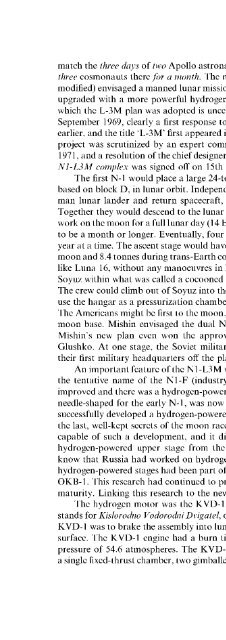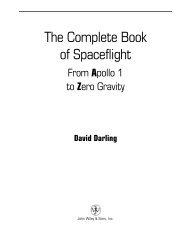Soviet and Russian Lunar Exploration
Soviet and Russian Lunar Exploration
Soviet and Russian Lunar Exploration
You also want an ePaper? Increase the reach of your titles
YUMPU automatically turns print PDFs into web optimized ePapers that Google loves.
match the three days of two Apollo astronauts on the moon with a <strong>Soviet</strong> plan to put<br />
three cosmonauts there for a month. The new Mishin plan, called the L-3M ('M' for<br />
modified) envisaged a manned lunar mission with two N-1 rockets. The N-1 would be<br />
upgraded with a more powerful hydrogen-powered upper stage. The exact date on<br />
which the L-3M plan was adopted is uncertain. The programme was first mooted in<br />
September 1969, clearly a first response to the American moon l<strong>and</strong>ing two months<br />
earlier, <strong>and</strong> the title 'L-3M' first appeared in print in documents in January 1970. The<br />
project was scrutinized by an expert commission under Mstislav Keldysh in spring<br />
1971, <strong>and</strong> a resolution of the chief designers Technical proposals for the creation of the<br />
N1-L3M complex was signed off on 15th May 1972.<br />
The first N-1 would place a large 24-tonne lunar l<strong>and</strong>er descent stage, the GB-1,<br />
based on block D, in lunar orbit. Independently, a second N-1 would deliver a threeman<br />
lunar l<strong>and</strong>er <strong>and</strong> return spacecraft, GB-2, to link up with the descent stage.<br />
Together they would descend to the lunar surface. Initially, three cosmonauts would<br />
work on the moon for a full lunar day (14 Earth days) but this would be later extended<br />
to be a month or longer. Eventually, four cosmonauts would live on the moon for a<br />
year at a time. The ascent stage would have a mass of 19.5 tonnes on launch from the<br />
moon <strong>and</strong> 8.4 tonnes during trans-Earth coast. Launch would be direct back to Earth,<br />
like Luna 16, without any manoeuvres in lunar orbit. The l<strong>and</strong>er would incorporate<br />
Soyuz within what was called a cocooned habitation block, or OB, a sort of hangar.<br />
The crew could climb out of Soyuz into the hangar, put on their spacesuits there <strong>and</strong><br />
use the hangar as a pressurization chamber before their descent to the lunar surface.<br />
The Americans might be first to the moon, but the <strong>Soviet</strong> Union would build the first<br />
moon base. Mishin envisaged the dual N-1 mission taking place in the late 1970s.<br />
Mishin's new plan even won the approval of long-time N-1 opponent, Valentin<br />
Glushko. At one stage, the <strong>Soviet</strong> military considered turning the moon base into<br />
their first military headquarters off the planet [16].<br />
An important feature of the N1-L3M was the redesign of the N-1 launcher, given<br />
the tentative name of the N1-F (industry code 11A52F). The airframe was much<br />
improved <strong>and</strong> there was a hydrogen-powered upper stage. The top part of the rocket,<br />
needle-shaped for the early N-1, was now bulkier <strong>and</strong> broader. The fact that Russia<br />
successfully developed a hydrogen-powered upper stage during the 1960s was one of<br />
the last, well-kept secrets of the moon race. The West had not believed the <strong>Russian</strong>s<br />
capable of such a development, <strong>and</strong> it did not come to light until India bought a<br />
hydrogen-powered upper stage from the <strong>Russian</strong>s in the 1990s. In fact, we now<br />
know that Russia had worked on hydrogen propulsion from 1960 onward <strong>and</strong> that<br />
hydrogen-powered stages had been part of the 1964 revision of the Soyuz complex in<br />
OKB-1. This research had continued to progress <strong>and</strong> by the late 1960s was reaching<br />
maturity. Linking this research to the new, improved N-1 made a lot of sense.<br />
The hydrogen motor was the KVD-1, built by the Isayev design bureau (KVD<br />
st<strong>and</strong>s for Kislorodno Vodorodni Dvigatel, or oxygen hydrogen engine). The role of the<br />
KVD-1 was to brake the assembly into lunar orbit <strong>and</strong> make the descent to the lunar<br />
surface. The KVD-1 engine had a burn time of 800 sec <strong>and</strong> a combustion chamber<br />
pressure of 54.6 atmospheres. The KVD-1 had a turbopump-operated engine with<br />
a single fixed-thrust chamber, two gimballed thrust engines, an operating period of up







